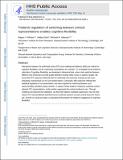| dc.contributor.author | Rikhye, Rajeev Vijay | |
| dc.contributor.author | Halassa, Michael | |
| dc.date.accessioned | 2021-04-06T14:08:54Z | |
| dc.date.available | 2021-04-06T14:08:54Z | |
| dc.date.issued | 2018-12 | |
| dc.identifier.issn | 1097-6256 | |
| dc.identifier.uri | https://hdl.handle.net/1721.1/130385 | |
| dc.description.abstract | Interactions between the prefrontal cortex (PFC) and mediodorsal thalamus are critical for cognitive flexibility, yet the underlying computations are unknown. To investigate frontothalamic substrates of cognitive flexibility, we developed a behavioral task in which mice switched between different sets of learned cues that guided attention toward either visual or auditory targets. We found that PFC responses reflected both the individual cues and their meaning as task rules, indicating a hierarchical cue-to-rule transformation. Conversely, mediodorsal thalamus responses reflected the statistical regularity of cue presentation and were required for switching between such experimentally specified cueing contexts. A subset of these thalamic responses sustained context-relevant PFC representations, while another suppressed the context-irrelevant ones. Through modeling and experimental validation, we find that thalamic-mediated suppression may not only reduce PFC representational interference but could also preserve unused cortical traces for future use. Overall, our study provides a computational foundation for thalamic engagement in cognitive flexibility. | en_US |
| dc.language.iso | en | |
| dc.publisher | Springer Science and Business Media LLC | en_US |
| dc.relation.isversionof | 10.1038/S41593-018-0269-Z | en_US |
| dc.rights | Article is made available in accordance with the publisher's policy and may be subject to US copyright law. Please refer to the publisher's site for terms of use. | en_US |
| dc.source | PMC | en_US |
| dc.title | Thalamic regulation of switching between cortical representations enables cognitive flexibility | en_US |
| dc.type | Article | en_US |
| dc.identifier.citation | Rikhye, Rajeev V. et al. “Thalamic regulation of switching between cortical representations enables cognitive flexibility.” Nature Neuroscience, 21, 12 (December 2018): 1753–1763 © 2018 The Author(s) | en_US |
| dc.contributor.department | McGovern Institute for Brain Research at MIT | en_US |
| dc.contributor.department | Massachusetts Institute of Technology. Department of Brain and Cognitive Sciences | en_US |
| dc.relation.journal | Nature Neuroscience | en_US |
| dc.eprint.version | Author's final manuscript | en_US |
| dc.type.uri | http://purl.org/eprint/type/JournalArticle | en_US |
| eprint.status | http://purl.org/eprint/status/PeerReviewed | en_US |
| dc.date.updated | 2021-04-06T12:49:15Z | |
| dspace.orderedauthors | Rikhye, RV; Gilra, A; Halassa, MM | en_US |
| dspace.date.submission | 2021-04-06T12:49:16Z | |
| mit.journal.volume | 21 | en_US |
| mit.journal.issue | 12 | en_US |
| mit.license | PUBLISHER_POLICY | |
| mit.metadata.status | Complete | |
